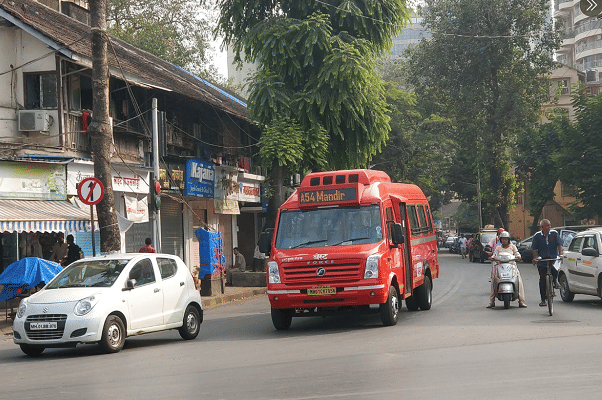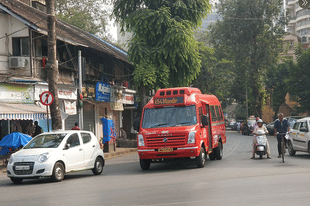Infrastructure
BEST Is Doing Better: How Mumbai Is On A Mission To Provide Improved Public Transport
Srikanth Ramakrishnan
Mar 11, 2020, 10:55 AM | Updated 09:46 PM IST
Save & read from anywhere!
Bookmark stories for easy access on any device or the Swarajya app.


In the summer of 2017, Mumbaikars were in for a rude shock. The city’s transport body, the Birhanmumbai Electricity Supply and Transport (BEST) undertaking decided to cut its losses and curtail all of its air-conditioned (AC) routes.
While the fleet had been bleeding the undertaking since they were inducted in 2007, it still had a few takers, especially in the summer months.
Subsequently, BEST slowly began running a few services using a fleet of 25 diesel-electric Tata Starbus hybrid buses, mostly concentrated in and around the business district of Bandra-Kurla Complex.
A series of disastrous fare hikes in 2015 drove away many commuters, which in turn saw share-autos and share-taxis rise across the city.
A much-needed fare revision including happy hours during non-peak timings gave minor relief but fizzled out in the long run, for the bad quality of buses left many passengers unhappy, much like what happened with the Mumbai Monorail.
In mid-2019, the undertaking finally slashed its fares, bringing down the minimum fares for regular buses to Rs 5 and AC buses to Rs 6, and capping them at Rs 20 and Rs 25 respectively.
Later in the year, BEST began procuring AC mini-buses and midi-buses under a wet lease model. Under this model, the bus and driver are provided by the private player while operating under BEST’s branding and using BEST’s existing infrastructure while ticketing is handled by the undertaking itself.
Initially launched on several trial routes in South Bombay (SoBo), BEST ultimately decided to expand the services to the suburbs, strategically starting with Andheri.
Andheri is the nerve centre of transit along the western suburbs. Andheri railway station is a major hub, for all suburban trains halt there, several north-bound services start there with a few outstation trains also having a halt.
A bulk of the existing line of the Mumbai Metro too passes through Andheri, connecting it with Ghatkopar. Among the under-construction metro lines, of which four more intersect Andheri at various points, Andheri remains the sole station with direct connectivity between the suburban network and the Metro. Naturally, it made sense for BEST to start here.
Manufactured by Force Motors, the 21-seater Minibus is operated as a conductor-less bus plying for a maximum of 5 km. This enables the undertaking to operate them at the minimum fare.
With a few exceptions, buses tend to ply with no more than three to six stops on the entire route. Some buses whose non-AC counterparts feature less than 10 stops allow passengers to board at all stops in one direction, while tickets are sold at the destination and disembark at all stops in the return journey where tickets are sold at the origin.
In most cases, there are conductors present at the stop where passengers are permitted to board the bus.
The Impact of The Mini-Bus
The surest way to gauge the success of anything would be to look at the opposition to it, particularly from the incumbents. In this case, opposition from auto-rickshaws and taxis, particularly the ones operating on a sharing-basis from railway stations. Barely a month after BEST began its services in Andheri, auto-rickshaws cried foul.
With 63 buses across 12 routes, the undertaking’s internal study determined that auto-rickshaws, especially share autos, were losing up to 5,300 trips per day. The logic was simple. These buses had a capacity of 21 seats plus seven standees and charged Rs 6 for a 5 km journey.
The minimum fare in a share-auto is Rs 8 and in a regular auto is Rs 18, both of which are well above the bus fare.
A month after their launch in SoBo, where autos don’t ply, kaali-peeli taxis protested by creating a traffic jam outside the Regional Transport Office (RTO) at Tardeo.
Under immense pressure from the taxi lobby, BEST briefly suspended one route only to relent and bring it back the next day.
The Problems That These Buses Face
Not everyone is enthused about these mini-buses though. For many a commuter, the lack of stops is rather tiresome. The allure of an AC bus at such cheap rates is gone when it doesn’t stop where you would normally get off or board the bus.
For others, the fact that these buses only travel up to 5 km is problematic. In certain cases, such as getting to Versova from Andheri station, one has to take two AC buses because the distance between the two is around 5.8 km, or stick to the non-AC bus.
BEST is still only operating buses at the basic fare stage without conductors. Conductors too aren’t too happy for two reasons – one, due to conductors being deployed at various bus stops for an entire shift and the other, due to the fact that there is an acute lack of communication between the private operators and BEST’s staff.
Transport experts too have had issues, especially with BEST focussing on launching all possible routes in one specific area before moving on further.
Expanding The Fleet
While BEST is actively expanding its fleet using the wet lease model, it can’t be looking at only running routes within the first fare stage. Along with the mini-buses, it has procured two fleets of AC midi-buses as well, again on wet lease.
The first lot is comprised of electric buses manufactured by BYD-Olectra that operates out of the Dharavi-Kalakilla depots where the Tata Starbus Diesel-Electric Hybrid fleet is also based and is used on routes in the east of the city.
The second lot consists of Tata Marcopolo buses powered by compressed natural gas (CNG) that are operational in SoBo. While the Olectra fleet operates with a conductor, and thus on long routes going as far 20 km, the latter, however, operates on smaller routes on the conductor-less model, one which has been experimented with on non-AC midi-buses with a few stops as well.
A basic understanding of the passengers would show that bus users never fully migrated to the Metro, and it was mostly share-auto and regular auto users who did.
The few bus users who did migrate to the Metro are slowly coming back to board the red bus, albeit this time the AC ones.
The current non-stop or limited stop system takes out a chunk of passengers from the overall route. Most AC routes are shortened versions of their non-AC counterparts to fit into the 5 km distance limit.
With these mini and midi-buses taking off those passengers, it leaves the regular buses emptier for the crowd that either wants to get off mid-way or go further.
If we look at Andheri alone, a lot of the non-AC buses serving the railway station, travel around 6-9 km. With the first five being handled by the AC buses, it leaves the buses emptier, but simultaneously leaves those passengers wishing to travel to the farthest point in the lurch.
Privatisation Remains A Good Model
Privatisation, especially the wet lease model, remains a good option for BEST. Operators are paid per kilometre per bus and BEST collects the fare entirely.
In 2010, BEST signed a deal with a firm named Asian Concierge to supply it with 50 diesel-powered Volvo B7RLE buses in lieu of full body advertisements on each bus.
Unfortunately, only six of those 50 made it to BEST’s Oshiwara depot, where they have been lying ever since.
No new news has come about Asian Concierge or the deal in the last few years and the buses can still be seen parked inside the Oshiwara depot’s premises.
By virtue of being India’s financial capital, Mumbai needs more AC buses and these mini-buses, while being a really good start, won’t be enough in the long run.
BEST needs to procure full length buses and get them back on the streets. It was after all, among the first cities to introduce AC buses for city uses, as far back as 1998.
The author would like to thank Nirav Kanodra for their inputs.
Srikanth’s interests include public transit, urban management and transportation infrastructure.





